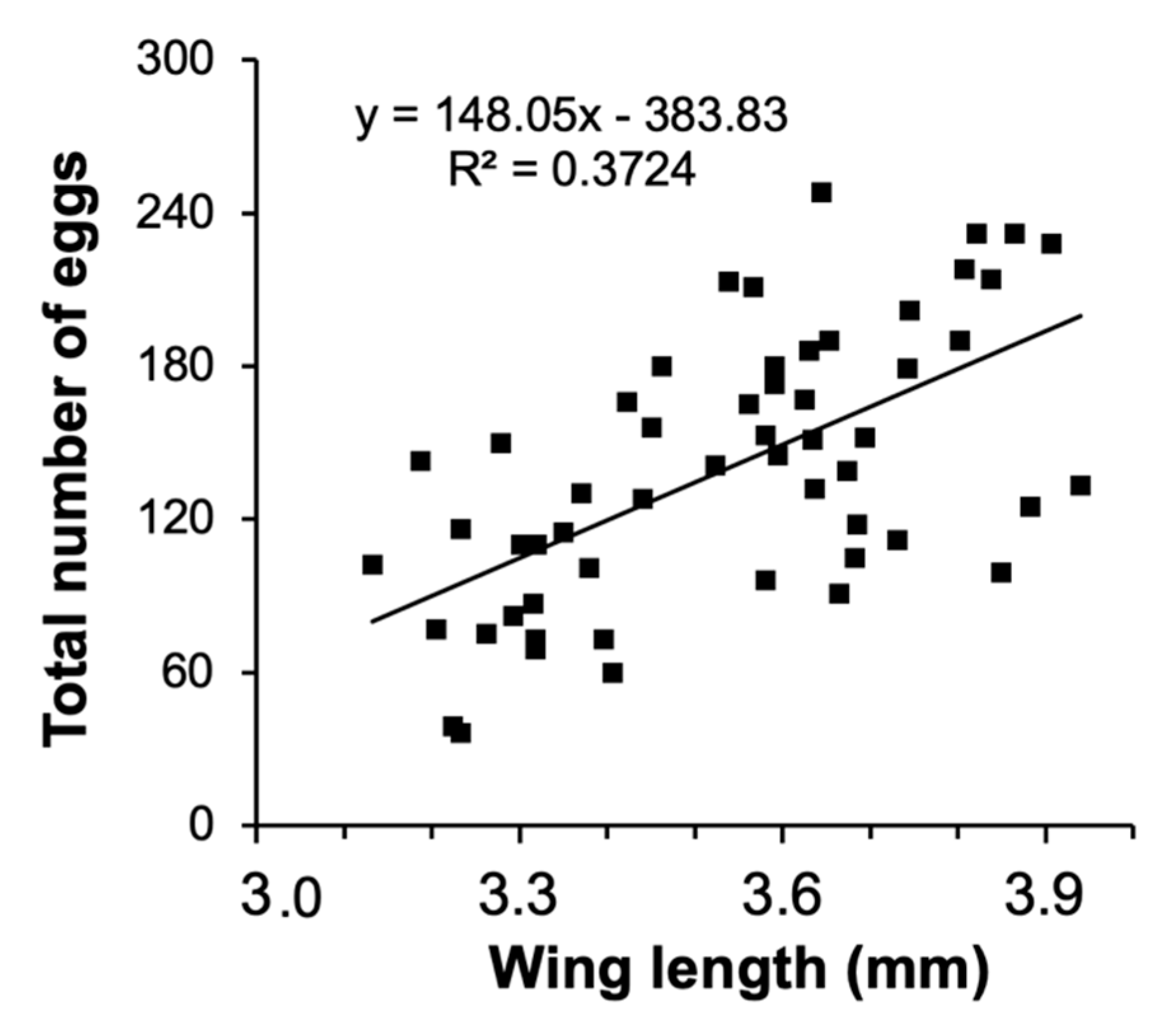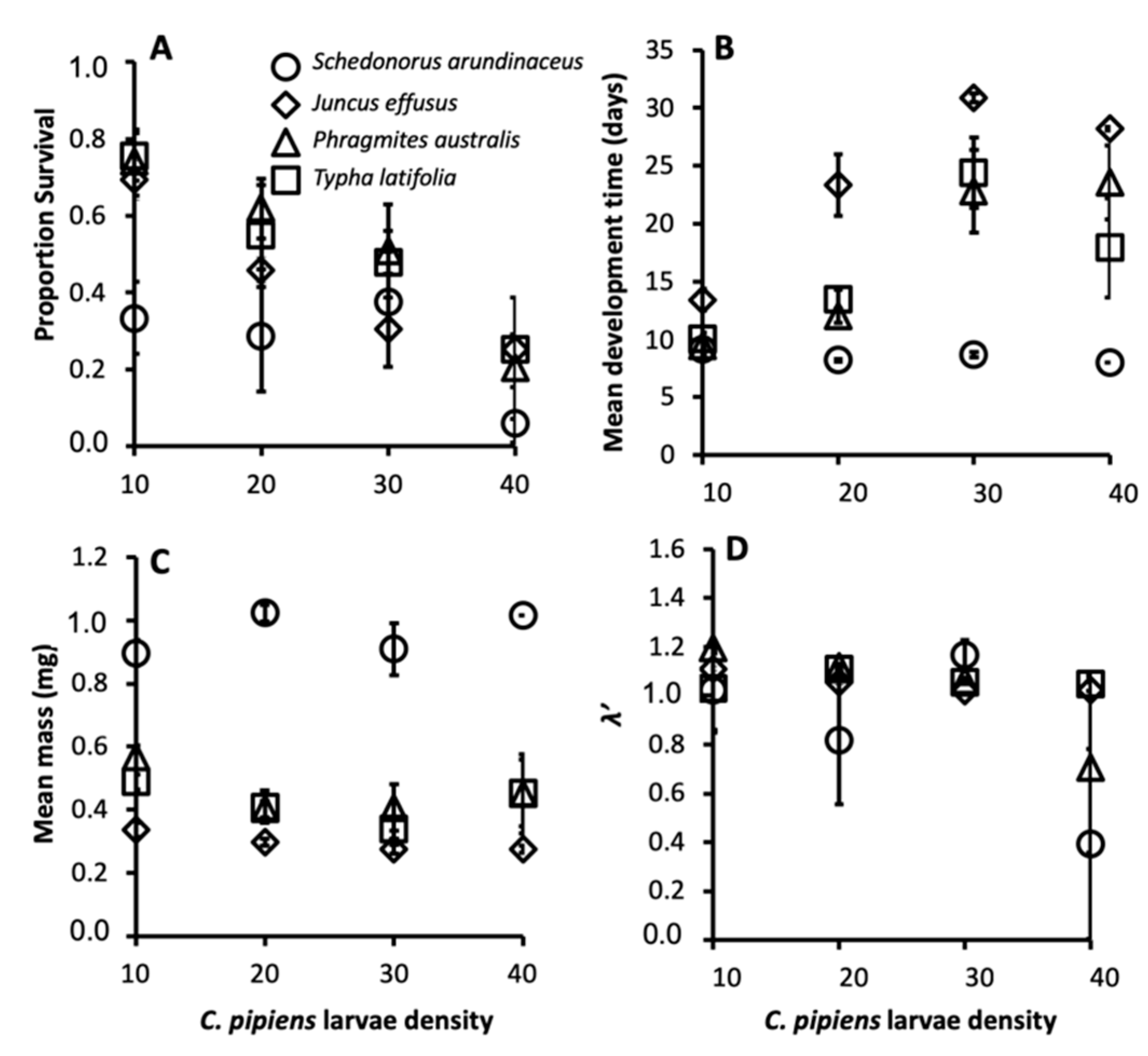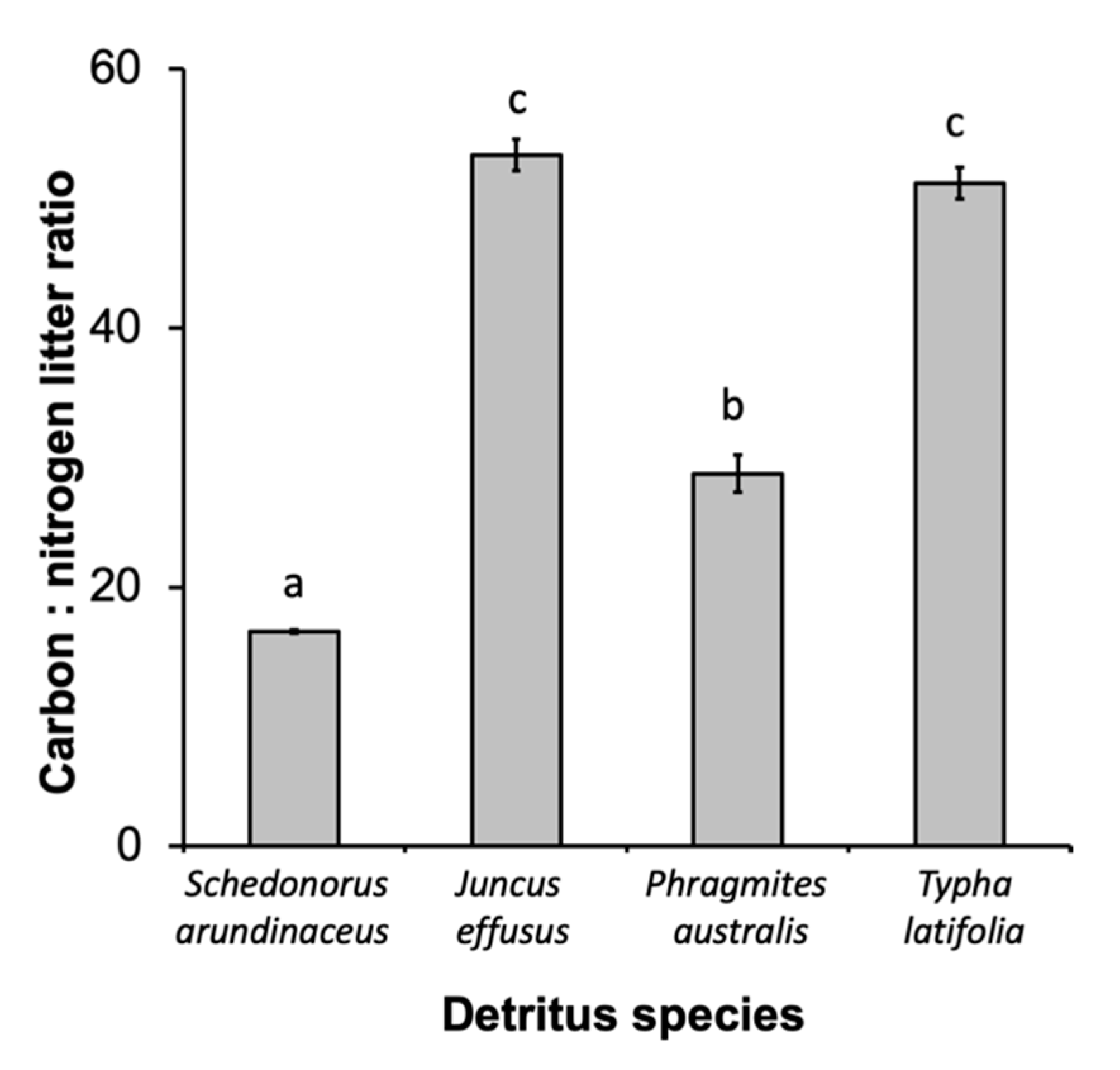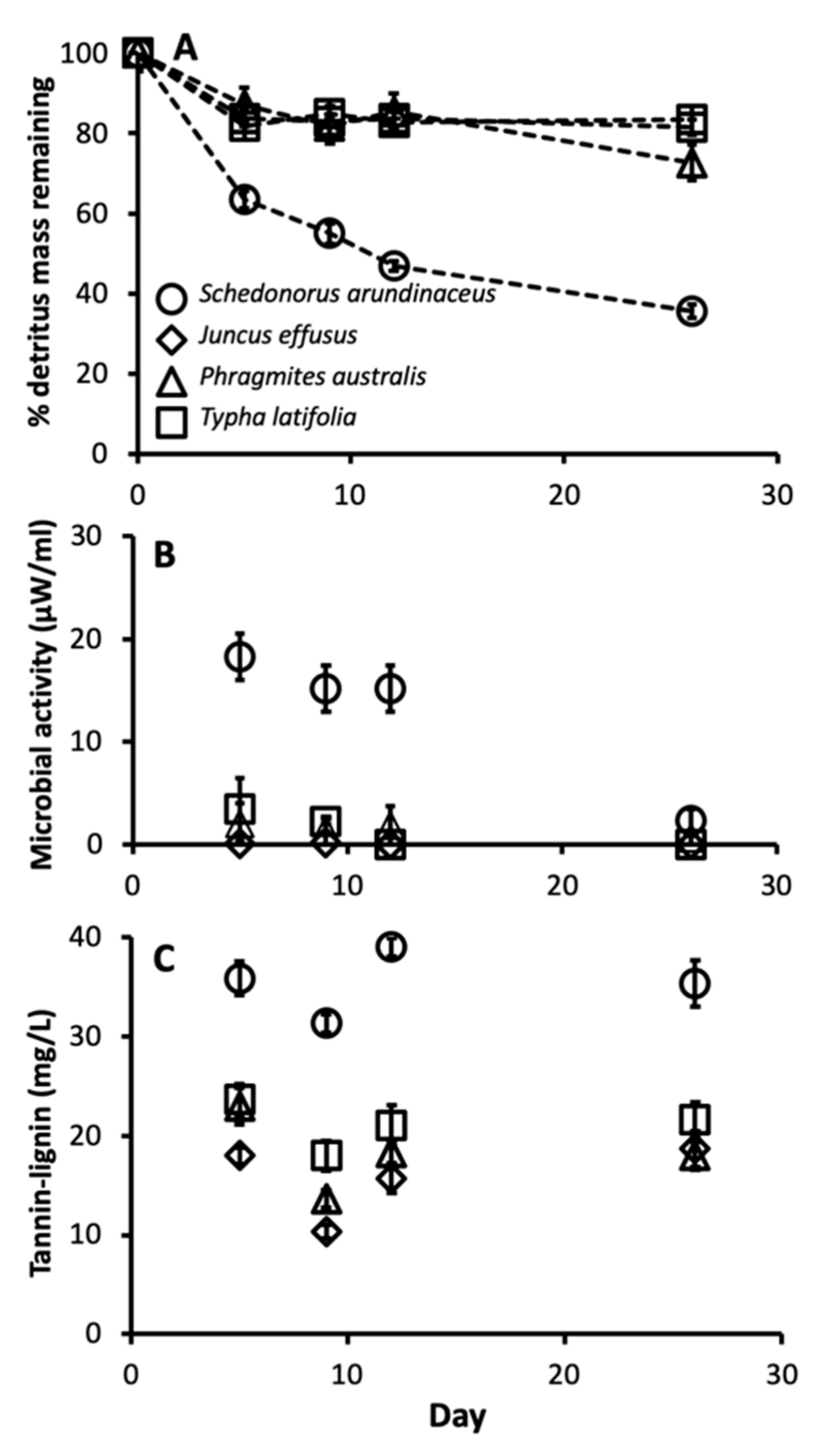Effects of Detritus on the Mosquito Culex pipiens: Phragmites and Schedonorus (Festuca) Invasion Affect Population Performance
Abstract
1. Introduction
2. Materials and Methods
2.1. Field Survey
2.2. Experimental Litter and Mosquitoes
2.3. Laboratory Experiment
2.4. Statistical Analyses
3. Results
3.1. Field Survey
3.2. Laboratory Experiment
4. Discussion
5. Conclusions
Supplementary Materials
Author Contributions
Funding
Acknowledgments
Conflicts of Interest
References
- Simberloff, D.; Von Holle, B. Positive interactions of nonindigenous species: Invasional meltdown? Biol. Invasions 1999, 1, 21–32. [Google Scholar] [CrossRef]
- Shea, K.; Chesson, P. Community ecology theory as a framework for biological invasions. Trends Ecol. Evol. 2002, 17, 170–176. [Google Scholar] [CrossRef]
- Ehrenfeld, J.G. Ecosystem consequences of biological invasions. Annu. Rev. Ecol. Evol. Syst. 2010, 41, 59–80. [Google Scholar] [CrossRef]
- Merritt, R.W.; Dadd, R.H.; Walker, E.D. Feeding-behavior, natural food, and nutritional relationships of larval mosquitoes. Annu. Rev. Entomol. 1992, 37, 349–376. [Google Scholar] [CrossRef] [PubMed]
- Batzer, D.P.; Wissinger, S.A. Ecology of insect communities in nontidal wetlands. Annu. Rev. Entomol. 1996, 41, 75–100. [Google Scholar] [CrossRef] [PubMed]
- Juliano, S.A. Species interactions among larval mosquitoes: Context dependence across habitat gradients. Annu. Rev. Entomol. 2009, 54, 37–56. [Google Scholar] [CrossRef]
- Kuller, Z.; Gasith, A. Comparison of the hatching process of the tadpole shrimps Triops cancriformis and Lepidurus apus lubbocki (Notostraca) and its relation to their distribution in rain-pools in Israel. Hydrobiologia 1996, 335, 147–157. [Google Scholar] [CrossRef]
- Wallace, J.R.; Merritt, R.W. Diel feeding periodicity of larval anopheline mosquitoes on microorganisms and microinvertebrates: A spatial and temporal comparison of Anopheles quadrimaculatus (Diptera: Culicidae) diets in a Michigan pond. J. Med. Entomol. 2004, 41, 853–860. [Google Scholar] [CrossRef]
- Wellborn, G.A.; Skelly, D.K.; Werner, E.E. Mechanisms creating community structure across a freshwater habitat gradient. Annu. Rev. Ecol. Syst. 1996, 27, 337–363. [Google Scholar] [CrossRef]
- Walker, E.D.; Lawson, D.L.; Merritt, R.W.; Morgan, W.T.; Klug, M.J. Nutrient dynamics, bacterial populations, and mosquito productivity in tree hole ecosystems and microcosms. Ecology 1991, 72, 1529–1546. [Google Scholar] [CrossRef]
- Yee, D.A.; Juliano, S.A. Consequences of detritus type in an aquatic microsystem: Effects on water quality, micro-organisms and performance of the dominant consumer. Freshw. Biol. 2006, 51, 448–459. [Google Scholar] [CrossRef] [PubMed]
- Gardner, A.M.; Allan, B.F.; Frisbie, L.A.; Muturi, E.J. Asymmetric effects of native and exotic invasive shrubs on ecology of the West Nile virus vector Culex pipiens (Diptera: Culicidae). Parasites Vectors 2015, 8, 329. [Google Scholar] [CrossRef] [PubMed]
- Barrera, R. Competition and resistance to starvation in larvae of container-inhabiting Aedes mosquitoes. Ecol. Entomol. 1996, 21, 117–127. [Google Scholar] [CrossRef]
- Murrell, E.G.; Juliano, S.A. Detritus type alters the outcome of interspecific competition between Aedes aegypti and Aedes albopictus (Diptera: Culicidae). J. Med. Entomol. 2008, 45, 375–383. [Google Scholar] [CrossRef]
- Fish, D.; Carpenter, S.R. Leaf litter and larval mosquito dynamics in tree-hole ecosystems. Ecology 1982, 63, 283–288. [Google Scholar] [CrossRef]
- Dieng, H.; Mwandawiro, C.; Boots, M.; Morales, R.; Satho, T.; Tuno, N.; Tsuda, Y.; Takagi, M. Leaf litter decay process and the growth performance of Aedes albopictus larvae (Diptera: Culicidae). J. Vector Ecol. 2002, 27, 31–38. [Google Scholar]
- Costanzo, K.S.; Muturi, E.J.; Lampman, H.L.; Alto, B.W. The effects of resource type and ratio on competition with Aedes albopictus and Culex pipiens (Diptera: Culicidae). J. Med. Entomol. 2011, 48, 29–38. [Google Scholar] [CrossRef]
- Daugherty, M.P.; Alto, B.W.; Juliano, S.A. Invertebrate carcasses as a resource for competing Aedes albopictus and Aedes aegypti (Diptera: Culicidae). J. Med. Entomol. 2000, 37, 364–372. [Google Scholar] [CrossRef]
- Muturi, E.J.; Allan, B.F.; Ricci, J. Influence of leaf detritus type on production and longevity of container-breeding mosquitoes. Environ. Entomol. 2012, 41, 1062–1068. [Google Scholar] [CrossRef]
- Blackmore, M.S.; Lord, C.C. The relationship between size and fecundity in Aedes albopictus. J. Vector Ecol. 2000, 35, 212–217. [Google Scholar]
- Armbruster, P.; Hutchinson, R.A. Pupal mass and wing length as indicators of fecundity in Aedes albopictus and Aedes geniculatus (Diptera: Culicidae). J. Med. Entomol. 2002, 39, 699–704. [Google Scholar] [CrossRef] [PubMed]
- Leisnham, P.T.; Lounibos, L.P.; O’Meara, G.F.; Juliano, S.A. Interpopulation divergence in competitive interactions of the mosquito Aedes albopictus. Ecology 2009, 90, 2405–2413. [Google Scholar] [CrossRef] [PubMed]
- Leisnham, P.T.; Sala, L.M.; Juliano, S.A. Geographic variation in adult survival and reproduction of the mosquito Aedes albopictus. J. Med. Entomol. 2008, 45, 210–221. [Google Scholar] [CrossRef]
- Alto, B.W.; Lounibos, L.P.; Higgs, S.; Juliano, S.A. Larval competition differentially affects arbovirus infection in Aedes mosquitoes. Ecology 2005, 86, 3279–3288. [Google Scholar] [CrossRef]
- Alto, B.W.; Lounibos, L.P.; Mores, C.N.; Reiskind, M.H. Larval competition alters susceptibility of adult Aedes mosquitoes to dengue infection. Proc. R. Soc. B Biol. Sci. 2008, 275, 463–471. [Google Scholar] [CrossRef]
- Zirbel, K.; Eastmond, B.; Alto, B.W. Parental and offspring larval diets interact to influence life-history traits and infection with dengue virus in Aedes aegypti. R. Soc. Open Sci. 2018, 5, 180539. [Google Scholar] [CrossRef]
- Livdahl, T.P.; Sugihara, G. Non-linear interactions of populations and the importance of estimating per capita rates of change. J. Anim. Ecol. 1984, 53, 573–580. [Google Scholar] [CrossRef]
- Costanzo, K.S.; Westby, K.M.; Medley, K.A. Genetic and environmental influences on the size-fecundity relationship in Aedes albopictus (Diptera: Culicidae): Impacts on population growth estimates? PLoS ONE 2018, 13, e0201465. [Google Scholar] [CrossRef]
- Smith, D.L.; Battle, K.E.; Hay, S.I.; Barker, C.M.; Scott, T.W.; McKenzie, F.E. Ross, macdonald, and a theory for the dynamics and control of mosquito-transmitted pathogens. PLoS Pathog. 2012, 8, e1002588. [Google Scholar] [CrossRef]
- Hawley, W.A. The effect of larval density on adult longevity of a mosquito, Aedes sierrentis: Epidemiological consequences. J. Anim. Ecol. 1985, 54, 955–964. [Google Scholar] [CrossRef]
- LaDeau, S.L.; Allan, B.F.; Leisnham, P.T.; Levy, M.Z. The ecological foundations of transmission potential and vector-borne disease in urban landscapes. Funct. Ecol. 2015, 29, 889–901. [Google Scholar] [CrossRef] [PubMed]
- Ukubuiwe, A.C.; Ojianwuna, C.C.; Olayemi, I.K.; Arimoro, F.O.; Omalu, I.C.J.; Ukubuiwe, C.C.; Baba, B.M. Quantifying the influence of larval density on disease transmission indices in Culex quinquefasciatus, the major African vector of filariasis. Int. J. Insect Sci. 2019, 11, 1179543319856022. [Google Scholar] [CrossRef] [PubMed]
- Sota, T.; Mogi, M. Interspecific variation in desiccation survival time of Aedes (Stegomyia) mosquito eggs is correlated with habitat and egg size. Oecologia 1992, 90, 353–358. [Google Scholar] [CrossRef] [PubMed]
- Mercer, D.R.; Anderson, J.R. Tannins in treehole habitats and their effects on Aedes sierrensis (Diptera: Culicidae) production and parasitism by Lambornella clarki (Ciliophera: Tetrahymenidae). J. Med. Entomol. 1994, 31, 159–167. [Google Scholar] [CrossRef]
- Reiskind, M.H.; Greene, K.L.; Lounibos, L.P. Leaf species identity and combination affect performance and oviposition choice of two container mosquito species. Ecol. Entomol. 2009, 34, 447–456. [Google Scholar] [CrossRef]
- Mackay, A.J.; Muturi, E.J.; Ward, M.P.; Allan, B.F. Cascade of ecological consequences for West Nile virus transmission when aquatic macrophytes invade stormwater habitats. Ecol. Appl. 2015, 26, 219–232. [Google Scholar] [CrossRef]
- Kesavaraju, B.; Khan, D.F.; Gaugler, R. Behavioral differences of invasive container-dwelling mosquitoes to a native predator. J. Med. Entomol. 2011, 48, 526–532. [Google Scholar] [CrossRef]
- Vinogradova, E.B. Culex Pipiens Pipiens Mosquitoes; Taxonomy, Distribution, Ecology, Physiology, Genetics, Applied Importance and Control; Pensoft: Sofia, Bulgaria, 2000. [Google Scholar]
- Lounibos, L.P. Invasions by insect vectors of human disease. Annu. Rev. Entomol. 2002, 47, 233–266. [Google Scholar] [CrossRef]
- Chaulk, A.C.; Carson, K.P.; Whitney, H.G.; Fonseca, D.M.; Chapman, T.W. The Arrival of the northern house mosquito Culex pipiens (Diptera: Culicidae) on Newfoundland’s Avalon Peninsula. J. Med. Entomol. 2016, 53, 1364–1369. [Google Scholar] [CrossRef]
- Byrne, K.; Nichols, R.A. Culex pipiens in London Underground tunnels: Differentiation between surface and subterranean populations. Heredity 1999, 82, 7–15. [Google Scholar] [CrossRef]
- Apperson, C.S.; Harrison, B.A.; Unnasch, T.R.; Hassan, H.K.; Irby, W.S.; Savage, H.M.; Aspen, S.E.; Watson, D.W.; Rueda, L.M.; Engber, B.R.; et al. Host-feeding habits of Culex and other mosquitoes (Diptera: Culicidae) in the Borough of Queens in New York City, with characters and techniques for identification of Culex mosquitoes. J. Med. Entomol. 2002, 39, 777–785. [Google Scholar] [CrossRef] [PubMed]
- Lampman, R.L.; Krasavin, N.M.; Szyska, M.; Novak, R.J. A comparison of two West Nile virus detection assays (TaqMan reverse transcriptase polymerase chain reaction and VecTest antigen assay) during three consecutive outbreaks in northern Illinois. J. Am. Mosq. Control Assoc. 2006, 22, 76–86. [Google Scholar] [CrossRef]
- Spielman, A.; Andreadis, T.G.; Apperson, C.S.; Cornel, A.J.; Day, J.F.; Edman, J.D.; Fish, D.; Harrington, L.C.; Kiszewski, A.E.; Lampman, R.; et al. Outbreak of West Nile virus in North America. Science 2004, 306, 1473–1475. [Google Scholar] [CrossRef] [PubMed]
- Washburn, J.O. Regulatory factors affecting larval mosquito populations in container and pool babitats—Implications for biological control. J. Am. Mosq. Control Assoc. 1995, 11, 279–283. [Google Scholar] [PubMed]
- Kwan, J.A.; Riggs-Nagy, J.M.; Fritz, C.L.; Shindelbower, M.; Castro, P.A.; Kramer, V.L.; Metzger, M.E. Mosquito production in stormwater treatment devices in the Lake Tahoe Basin, California. J. Am. Mosq. Control Assoc. 2008, 24, 82–89. [Google Scholar] [CrossRef]
- Stevens, M. Sort Rush Juncus effusus L. Available online: https://plants.usda.gov/plantguide/pdf/cs_juef.pdf (accessed on 2 July 2019).
- Stevens, M.; Hoag, C. Broad-Leafed Cattail Typha latifolia L. Available online: https://plants.usda.gov/plantguide/pdf/cs_tyla.pdf (accessed on 12 September 2019).
- Saltonstall, K. Cryptic invasion by a non-native genotype of the common reed, Phragmites australis, into North America. Proc. Natl. Acad. Sci. USA 2002, 99, 2445–2449. [Google Scholar] [CrossRef]
- Burdick, D.M.; Buchsbaum, R.; Holt, E. Variation in soil salinity associated with expansion of Phragmites australis in salt marshes. Environ. Exp. Bot. 2001, 46, 247–261. [Google Scholar] [CrossRef]
- Howard, R.J.; Travis, S.E.; Sikes, B.A. Rapid growth of a Eurasian haplotype of Phragmites australis in a restored brackish marsh in Louisiana, USA. Biol. Invasions 2008, 10, 369–379. [Google Scholar] [CrossRef]
- Magee, P. Common Reed: Phragmites australis (Cav.) Trin. ex Steud. Available online: http://plants.usda.gov/factsheet/pdf/fs_phau7.pdf (accessed on 9 December 2019).
- Henson, J.F. Tall Fescue: Lolium arundinaceum (Schreb.) S.J. Darbyshire. Available online: http://plants.usda.gov/plantguide/pdf/pg_loar10.pdf (accessed on 9 September 2019).
- Juliano, S.A. Species introduction and replacement among mosquitoes: Interspecific resource competition or apparent competition? Ecology 1998, 79, 255–268. [Google Scholar] [CrossRef]
- Mattingly, P.F. The problem of biological races in the Culex pipiens complex. Proc. Linn. Soc. Lond. 1952, 163, 53–57. [Google Scholar] [CrossRef]
- Harbach, R.E.; Harrison, B.A.; Gad, A.M. Culex (Culex) molestus Forskal (Diptera, Culicidae): Neotype designation, description, variation, and taxonomic status. Proc. Entomol. Soc. Wash. 1984, 86, 521–542. [Google Scholar]
- Detinova, T.S. Age-Grouping Methods in Diptera of Medical Importance; World Health Organization: Geneva, Switzerland, 1962; p. 216. [Google Scholar]
- Zhang, H.; Liu, J.; Li, C.; Momen, B.; Kohanski, R.; Pick, L. Deletion of Drosophila insulin-like peptides causes growth defects and metabolic abnormalities. Proc. Natl. Acad. Sci. USA 2009, 106, 19617–19622. [Google Scholar] [CrossRef] [PubMed]
- Braissant, O.; Wirz, D.; Gopfert, B.; Daniels, A. Use of isothermal microcalorimeter to monitor microbial activities. FEMS Microbiol. Lett. 2010, 303, 1–18. [Google Scholar] [CrossRef] [PubMed]
- Villena, O.; Momen, B.; Sullivan, J.; Leisnham, P. Effects of ultraviolet radiation on metabolic rate and fitness of Aedes albopictus and Culex pipiens mosquitoes. PeerJ 2018, 6, e6133. [Google Scholar] [CrossRef]
- SAS Institute Inc. SAS User’s Guide: Statistics; Version 9.1; SAS Institute Inc.: Cary, NC, USA, 2003. [Google Scholar]
- Cassell, D.L. A Randomization-Test Wrapper for SAS PROCs; SAS Institute Inc.: Cary, NC, USA, 2011. [Google Scholar]
- Briegel, H.; Timmermann, S.E. Aedes albopictus (Diptera: Culicidae): Physiological aspects of development and reproduction. J. Med. Entomol. 2001, 38, 566–571. [Google Scholar] [CrossRef]
- Ameneshewa, B.; Service, M.W. The relationship between female body size and survival rate of the malaria vector Anopheles arabiensis in Ethiopia. Med. Vet. Entomol. 1996, 10, 170–172. [Google Scholar] [CrossRef]
- Alto, B.W.; Muturi, E.J.; Lampman, R.L. Effects of nutrition and density in Culex pipiens. Med. Vet. Entomol. 2012, 26, 396–406. [Google Scholar] [CrossRef]
- Alto, B.W.; Bettinardi, D.J.; Ortiz, S. Interspecific larval competition differentially impacts adult survival in dengue vectors. J. Med. Entomol. 2015, 52, 163–170. [Google Scholar] [CrossRef]
- Juliano, S.A.; Ribeiro, G.S.; Maciel-De-Freitas, R.; Castro, M.G.; Codeco, C.; Lourenco-de-Oliveira, R.; Lounibos, L.P. She’s a femme fatale: Low-density larval development produces good disease vectors. Mem. Inst. Oswaldo Cruz 2014, 109, 1070–1077. [Google Scholar] [CrossRef]
- Lounibos, L.P.; Suarez, S.; Menendez, Z.; Nishimura, N.; Escher, R.L.; SM, O.C.; Rey, J.R. Does temperature affect the outcome of larval competition between Aedes aegypti and Aedes albopictus? J. Vector Ecol. 2002, 27, 86–95. [Google Scholar]
- Leisnham, P.T.; Juliano, S.A. Interpopulation differences in competitive effect and response of the mosquito Aedes aegypti and resistance to invasion by a superior competitor. Oecologia 2010, 164, 221–230. [Google Scholar] [CrossRef] [PubMed][Green Version]
- Costanzo, K.S.; Mormann, K.; Juliano, S.A. Asymmetrical competition and patterns of abundance of Aedes albopictus. J. Med. Entomol. 2005, 42. [Google Scholar] [CrossRef]
- Xue, R.; Barnard, D.R.; Schreck, C.E. Influence of body size and age of Aedes albopictus on human host attack rates and the repellency of deet. J. Am. Mosq. Control Assoc. 1995, 11, 50–53. [Google Scholar] [PubMed]
- Briegel, H. Physiological bases of mosquito ecology. J. Vector Ecol. 2003, 28, 1–11. [Google Scholar] [PubMed]
- Smith, C.; Baldwin, A.H.; Sullivan, J.; Leisnham, P.T. Effects of elevated atmospheric CO2 on competition between the mosquitoes Aedes albopictus and Ae. triseriatus via changes in litter quality and production. J. Med. Entomol. 2013, 50, 521–532. [Google Scholar] [CrossRef]
- Sota, T. Performance of Aedes albopictus and A. riversi larvae (Diptera: Culicidae) in waters that contain tannic acid and decaying leaves: Is the treehole species better adapted to treehole water? Ann. Entomol. Soc. Am. 1993, 86, 450–457. [Google Scholar] [CrossRef]
- Christensen, J.R.; Crumpton, W.G.; Van der Valk, A.G. Estimating the breakdown and accumulation of emergent macrophyte litter: A mass-balance approach. Wetlands 2009, 29, 204–214. [Google Scholar] [CrossRef]
- Kuehn, K.A.; Suberkropp, K. Decomposition of standing litter of the freshwater emergent macrophyte Juncus effusus. Freshw. Biol. 1998, 40, 717–727. [Google Scholar] [CrossRef]
- Schultz, D. Current Status of Vegetation Management in Roadside Ditches and Stormwater Management Facilities: Implications for Stormwater Quality; Center for Urban Water Resources Management, Department of Civil Engineering, University of Washington: Seattle, WA, USA, 1998; p. 30. [Google Scholar]
- Shewhart, L.; McEwan, R.W.; Benbow, M.E. Evidence for facilitation of Culex pipiens (Diptera: Culicidae) life history traits by the nonnative invasive shrub Amur Honeysuckle (Lonicera maackii). Environ. Entomol. 2014, 43, 1584–1593. [Google Scholar] [CrossRef]




| Plant Species | Number of Sites | Area (m2) | Litter Per Area (g/m2) | Estimated Volume (L) | Total Litter Per Volume (g/L) | Wet Litter Per Volume (g/L) | Mosquitoes/Volume (no./L) | Mosquitoes/Wet Litter (no./g) |
|---|---|---|---|---|---|---|---|---|
| S. arundinaceus | 3 | 0.56 ± 0.12 (0.40–0.80) | 556.1 ± 198.6 (236.3–920.0) | 169.3 ± 34.3 (104.0–220.0) | 1.91 ± 0.82 (1.02–3.54) | 1.63 ± 0.84 (0.66–3.31) | 10.7 ± 4.1 (4.0–18.0) | 7.5 ± 1.8 (5.43–11.00) |
| P. australis | 4 | 0.95 ± 0.20 (0.40–1.40) | 846.3 ± 73.1 (659.3–999.0) | 279.0 ± 54.7 (148.0–378.0) | 2.88 ± 0.49 (2.26–4.34) | 1.19 ± 0.21 (0.74–1.61) | 22.3 ± 5.9 (7.0–33.3) | 18.5 ± 3.9 (7.4–25.8) |
| T. latifolia | 4 | 0.66 ± 0.22 (0.32–1.30) | 602.5 ± 109.1 (320.0–830.0) | 206.9 ± 69.6 (92.0–390.0) | 2.05 ± 0.56 (1.07–3.61) | 1.40 ± 0.55 (0.47–3.00) | 15.3 ± 3.2 (8.0–22.0) | 19.1 ± 8.3 (2.7–40.7) |
| J. effusus | 3 | 0.56 ± 0.12 (0.40–0.80) | 136.9 ± 12.5 (123.8–162.0) | 151.3 ± 23.1 (112.0–192.0) | 0.50 ± 0.02 (0.45–0.54) | 0.39 ± 0.01 (0.37–0.40) | 8.8 ± 2.9 (3.0–12.5) | 22.1 ± 7.2 (8.0–31.6) |
| Total | 14 | 0.70 ± 0.10 (0.32–1.40) | 562.4 ± 85.1 (123.8–999.0) | 207.5 ± 27.6 (92.0–390.0) | 1.92 ± 0.33 (0.45–4.34) | 1.18 ± 0.25 (0.37–3.31) | 14.9 ± 2.40 (3.0–33.3) | 17.1 ± 3.1 (2.70–40.7) |
| Variable | λ′ | Survivorship | Mass | Development Time | ||||||
|---|---|---|---|---|---|---|---|---|---|---|
| Pr > F | df | F Value | Pr > F | df | F Value | Pr > F | df | F Value | Pr > F | |
| Detritus | 0.4190 | 3 | 1.43 | 0.2412 | 3 | 17.05 | <0.0001 | 3 | 1.94 | 0.1332 |
| Density | 0.2330 | 1 | 13.06 | 0.0006 | 1 | 2.40 | 0.1270 | 1 | 69.88 | <0.0001 |
| Density x Detritus | 0.2310 | 3 | 0.30 | 0.8256 | 3 | 1.54 | 0.2137 | 3 | 8.98 | <0.0001 |
| Error | 65 | 58 | 58 | |||||||
| Variable | Detritus decay | Microbial Activity | Tannin-Lignin | ||||||
|---|---|---|---|---|---|---|---|---|---|
| df | F Value | Pr > F | df | F Value | Pr > F | df | F Value | Pr > F | |
| Detritus | 3 | 716.15 | <0.0001 | 3 | 41.31 | <0.0001 | 3 | 72.91 | <0.0001 |
| Day | 1 | 221.94 | <0.0001 | 1 | 39.67 | <0.0001 | 1 | 1.68 | 0.1980 |
| Day x Detritus | 3 | 36.45 | <0.0001 | 3 | 3.90 | 0.0122 | 3 | 0.76 | 0.5213 |
| Error | 88 | 72 | 88 | ||||||
© 2019 by the authors. Licensee MDPI, Basel, Switzerland. This article is an open access article distributed under the terms and conditions of the Creative Commons Attribution (CC BY) license (http://creativecommons.org/licenses/by/4.0/).
Share and Cite
Leisnham, P.T.; Scott, B.; Baldwin, A.H.; LaDeau, S.L. Effects of Detritus on the Mosquito Culex pipiens: Phragmites and Schedonorus (Festuca) Invasion Affect Population Performance. Int. J. Environ. Res. Public Health 2019, 16, 4118. https://doi.org/10.3390/ijerph16214118
Leisnham PT, Scott B, Baldwin AH, LaDeau SL. Effects of Detritus on the Mosquito Culex pipiens: Phragmites and Schedonorus (Festuca) Invasion Affect Population Performance. International Journal of Environmental Research and Public Health. 2019; 16(21):4118. https://doi.org/10.3390/ijerph16214118
Chicago/Turabian StyleLeisnham, Paul T., Brandon Scott, Andrew H. Baldwin, and Shannon L. LaDeau. 2019. "Effects of Detritus on the Mosquito Culex pipiens: Phragmites and Schedonorus (Festuca) Invasion Affect Population Performance" International Journal of Environmental Research and Public Health 16, no. 21: 4118. https://doi.org/10.3390/ijerph16214118
APA StyleLeisnham, P. T., Scott, B., Baldwin, A. H., & LaDeau, S. L. (2019). Effects of Detritus on the Mosquito Culex pipiens: Phragmites and Schedonorus (Festuca) Invasion Affect Population Performance. International Journal of Environmental Research and Public Health, 16(21), 4118. https://doi.org/10.3390/ijerph16214118






